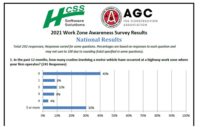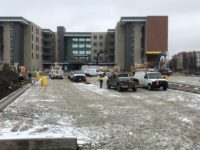A recent letter sent to ENR took issue with my story about a work site safety survey and how speed cameras are used.
"Speed cameras in work zones are for revenue. If not, then why do we not do things like adopt the zipper merge, and post 85th percentile speed limits? Low speed limits cause a decent speed variation between the vehicles, which promotes tailgating, constant passing, and rapidly approaching a vehicle," wrote James Sikorski Jr., Pennsylvania Advocate for the National Motorists Association, after reading the story on AGC's survey of workzone crashes.
The Associated General Contractors of America, as you might imagine, saw things differently according its survey, which said 68% of respondents had at least one moving vehicle accident at a work site in 2019.
"We do have a problem of people speeding and being dangerous in our work zones,” says Jason Koss, industry relations director for the Constructors Association of Western Pennsylvania, the AGC chapter for Pittsburgh-area firms. “Speeding and distracted driving do occur."
AGC's data comes from 200 member contractors that do road and highway work and is just that—data/
But as a reporter who's been around the block a few times, I did sympathize with Mr. Sikorski's complaint. He further elaboratesd in his letter that the state of Michigan's strategy is to put most freeway work zones behind concrete barriers, limiting crash risk from passing cars and allowing drivers to see that workers are safe.
Freeway limits are usually 70 mph in Michigan, but are sometimes reduced to 60 mph if warranted. If work areas are close to the travel lanes or there are some minor lane shifts, the basic limit drops by 10 mph. Signs tell motorists “45 Where Workers Present,” which forces drivers to look for workers who might be at risk, and slow down near them. The strategy seems to work for Michigan.
The complaint that speed cameras are for revenue is also very much rooted in reality. As a resident of Illinois, I know this all too well based on reporting I've done involving kickbacks to politicians to place both speed and red light cameras on roads, and how companies such as red light camera provider SafeSpeed LLC involved themselves in corrupt municipal politics.
But painting every speed camera operator as corrupt as SafeSpeed was is as wrong as saying a one-size-fits-all approach to work zone safety is effective in every state or for every department of transportation.
Contractors need to communicate with DOTs and municipal authorities about what technologies work to keep crews safe, and DOTs and municipalities need to make decisions about work site technology based on contractor feedback and real data from industry groups such as AGC and motorists groups like NMA, rather than based on politician kickbacks and commands from on high.
There is certainly a role for technology, including speed cameras, to play in work site safety. But that role should not become a tool to take advantage of motorists. The needs of both drivers and workers can be accomplished with proper controls and transparent processes from DOTs, municipalities and, yes, local politicians.
But one result that neither motorists nor contractors want is one ENR covered this week, involving a truck driver, distracted by his phone, who caused a fatal crash at a Minnesota work site. The driver received a three-year prison sentence on July 14.
Both groups can help avoid this type of accident if they leave the politics out and work together on solutions.






Post a comment to this article
Report Abusive Comment